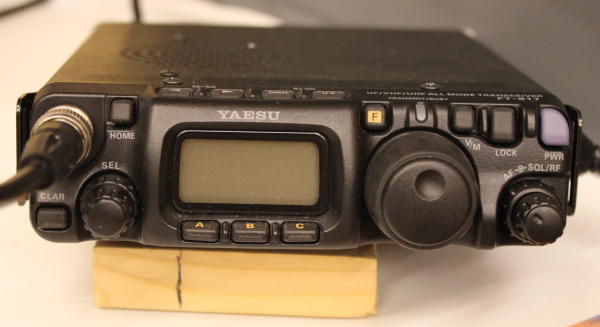Our first rig is the FT817. This is a portable 5W transceiver covering all bands from HF to 70cm (with the exception of 4m).
This is an execellent unit: so far it's done everything asked of it. For portable operation it is unmatched; simply take it out and operate. For "base" use its controls are really too cramped. You can do a lot with the various menus, but you **have** to navigate them. With a PC connection and "Ham Radio Deluxe" it is easy to configure; that's probably a better way to use it when at home.
It does need some kind of "foot" to tilt the display up; mine is an offcut of timber for the moment!
When I was a kid I had a Yaesu FT202 rig. It had 3 crystal controlled channels with space for 3 more crystals for £100. Technology has moved since then! I ordered at Quansheng TG-UV2 dual band 2m/70cm handheld; for £72 delivered to my door it covered all of two bands, was about a third of the size and cost about a third of the price in real terms. That price included a spare battery, USB lead and speaker/microphone.
In performance terms it is excellent. We get good audio reports; it covers all of 2m and 70cm, has 5W output and apparently ~10 hours battery life.
Its user interface is weak: everything has to be done through 16 buttons and a 2 line LCD display. Some menus are obvious, but others never will be. Luckily it has 200 easily accessed memories; these can be programmed from a PC.
Setting up the PC interface wasn't good, and shouldn't be this difficult. I worked it out by trial and error; the approximate steps were:
- Install the USB cable software from the supplied CD
- Connect the USB cable
- Use control panel to move the new COM port to COM2
- Download the TG-UV2 software from a website
- Download an install a "RAR" image extractor program
- Extract the software to a local directory, then install it
- Reboot the PC
- Run the software
- Select English language from the menu bar
- Connect the radio
- finally you can read and write settings
I'm not yet sure how best to use the memories. So far I have a few local repeaters listed, and named by their callsign. It does mean that iput frequency/output frequency/CTCSS frequency are all correctly set, whih is otherwise difficult.
But, for £72 all in... excellent!

